
Credit: Kent State University
Many homes today include safety devices like smoke, radon and carbon monoxide detectors to warn us of threats our senses might not pick up in time. For those whose jobs regularly place them in harm’s way, though, advanced sensing technology is not as readily available.
Thanks to a rare Grant Opportunities for Academic Liaison with Industry (GOALI) award from the National Science Foundation (NSF), however, Kent State University researchers in the new Advanced Materials and Liquid Crystal Institute will be able to work with partners at Merck Performance Materials to advance life-saving sensory technology.
The three-year grant provides $330,000 for Torsten Hegmann, Ph.D., professor, Ohio Research Scholar and associate director of the Advanced Materials and Liquid Crystal Institute, and Elda Hegmann, Ph.D., assistant professor in the Advanced Materials and Liquid Crystal Institute and Department of Biological Sciences in Kent State’s College of Arts and Sciences, to study liquid crystal-nanoparticle sensors for detection of toxic gases and vapors.
“This research started almost back at the beginning of my academic career when I began studying nanomaterials and their interactions with liquid crystals,” Dr. Torsten Hegmann said. “We have worked in this process with Merck.”
Recent findings have shown that nanoparticles induce and alter the orientation of nematic liquid crystal molecules in direct contact with them. This interaction is the basis for creating highly sensitive and selective sensors that produce direct visual readouts or warnings without the use of electrical power.
The integrative sensor systems, which Drs. Torsten and Elda Hegmann have developed with Merck Performance Materials, can display an unmistakable warning in the form of text or an image in the presence of toxic gases and vapors, and provide parts-per-million level sensitivity.
Dr. Torsten Hegmann said the project may help them to produce various sensors uniquely designed for highly toxic gases that could protect the lives and health of firefighters and other first responders, military personnel in conflict zones and workers in chemical manufacturing, among others. Sensors for volatile gases and vapors exhaled by humans also could be used to monitor disease states and disease progression.
The project also is supported by a $100,000 grant from the TeCK Fund, a hybrid technology commercialization accelerator program jointly administered by Kent State and Cleveland State University, with funding provided by the Ohio Third Frontier Commission and the two universities.
“This is one of three Kent State projects we funded over the past year through the TeCK Fund, and it’s exactly the kind of research and innovation the partnership was intended to support,” said Steve Roberts, Kent State’s technology commercialization director. “We are very proud of the work the Hegmanns have done with Merck, and of course we are very pleased that the NSF saw the same potential in this project.”
###
For more information about Kent State’s Advanced Materials and Liquid Crystal Institute, visit http://www.
Photo Caption:
Kent State University researchers Elda and Torsten Hegmann pose with one of the sensors they created that detects toxic gases. The sensors can be made any shape or size and require no power to function.
Media Contacts:
Dan Pompili, [email protected], 330-672-0731
Emily Vincent, [email protected], 330-672-8595
Media Contact
Dan Pompili
[email protected]
330-672-0731
Original Source
https:/




